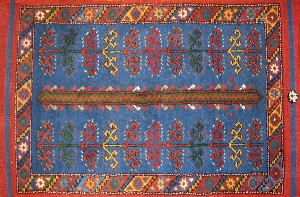A New Approach to an Ancient Art
by Abraham N. Bhutt
From ancient times, tribes in the Bastar region of central India, who trace their lineage to the 14th century weaver-saint-poet Kabir, have used roots of the aal tree (Morinda citrifolia L., Indian Mulberry) to dye and hand print their textiles and fabrics. One tribe would collect and prepare the dye, while another tribe would use it for dyeing the fabric. They use these roots by extracting them to create a natural vegetable dye, which is mixed with turmeric and iron to get variations on color. Their methods have remained constant through generations, producing only a limited range of colors–mostly a range of reds.
With the modern strains on the forest resources and a continued scarcity in the aal trees, the ability to extract dyes with the methods and quantities of the past is slipping away. These environmental changes have brought on challenges for the weavers and dyers of this region as they struggle to keep these traditions alive with limited materials and resources.
Photographs Copyright by Abraham N. Bhutt
K. Siva Kesava Rao, a practicing artist (designer, painter, print maker, and a master in natural dyeing and hand block printing) from Hyderabad, has spent time in the Bastar region helping to identify materials to create new dyes due to the scarcity of trees that had traditionally been extracted to produce these natural dyes. He stepped in to teach the tribes to use other resources from the forest and the villages to create new dyes. For example, he taught them to use iron buff with molasses to create black, jack fruit to create yellow, and marigolds and indigo for deeper colors.
Photographs Copyright by Abraham N. Bhutt
With a background in painting from MS University, Baroda, Gujarat (a prominent art school in India), Kesava Rao set out to apply his skills to a different medium, which is what led him to work in handloom and naturally dyed textiles. And since 1998, he, along with his wife Bina Rao, has been working diligently to revive the traditions of natural dyeing in their Creative Bee Design Studio in Hyderabad.
Bina Rao, also a graduate of Baroda in Fine Arts and a student of AEP Textile Design from 1981 to 1983 at the National Institute of Design, Ahmedabad, Gujarat, India, has helped several communities of weavers revive their skills and adapt to environmental and modern changes. Most specifically, Bina has worked with weavers of Uppeda doing gadwall weaving in inlay patterns. This work was traditionally done for the sari borders, but now the technique is utilized to create a varied or wider range of patterns for novel design applications.
The Raos' focus on using handloom-woven natural fiber fabrics, and commitment to the process of natural dyeing, has put them in the vanguard of the revival of traditional techniques of weaving and dyeing in India. In 1988 they formed Creative Bee in the city of Hyderabad, Andhra Pradesh, India, a design studio dedicated to textile and fashion design and production, with an emphasis on the handloom. They work to create designs that are then executed by the weavers who have worked in these arts for generations.
Photograph Copyright by Abraham N. Bhutt
The couple has been instrumental in recognizing and reviving a long heritage of traditional techniques. This is illustrated most innovatively in their establishment of Creative Bee Foundation, a trust dedicated to help artisans create high quality natural crafts. The foundation also provides training to artists, while helping to enhance their way of life through improved health and education. Creative Bee Foundation is supported solely through the work of Creative Bee Design Studio.
The Raos keenly recognize how the textile traditions of India continue to influence the larger growing Indian community whose interest in high-quality handloom and natural textiles–both for fashion and décor–continues to increase. Ultimately, their commitment is to see that the tribes, villages, and communities where these traditions originated can revive weaving and dyeing skills, adapting them through new methods and applications.
For more information on the Raos and Creative Bee studio, visit www.creativebee.biz.
 Turkey Red Journal
Turkey Red Journal
